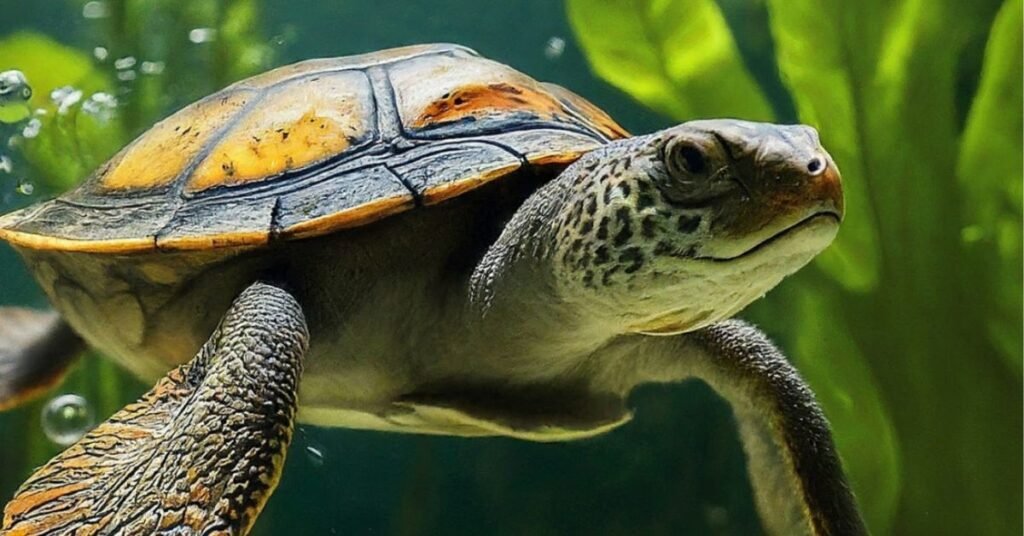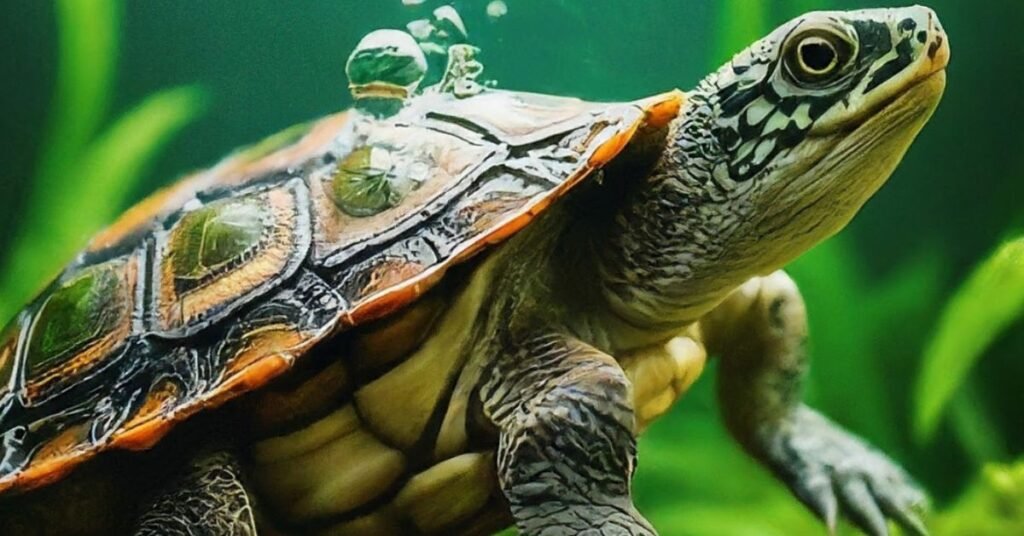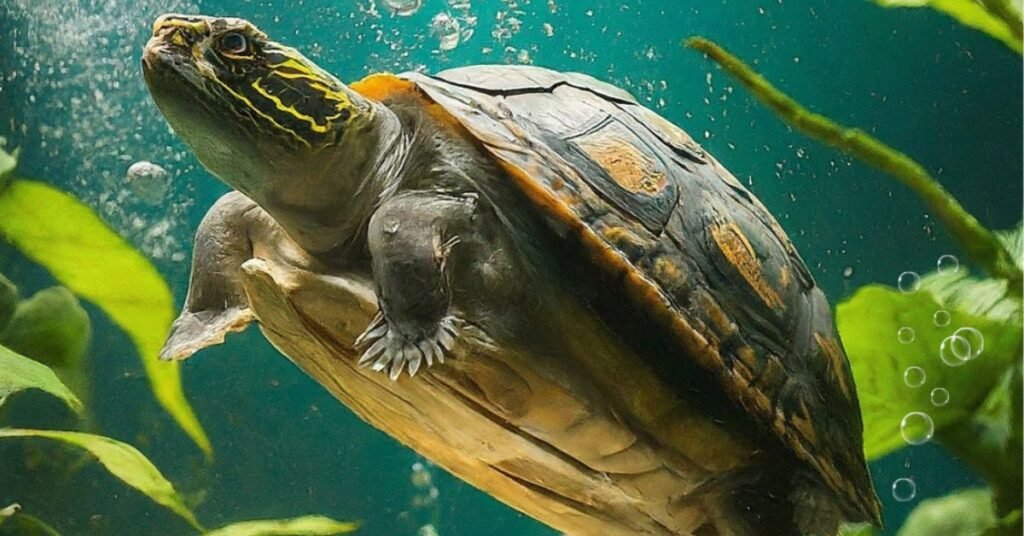Can turtles fart? This is a mysterious question that has recently piqued the interest of a significant number of pet owners, mainly those who are fond of turtles. Turtles can pass gas quite like any other being. Moreover, some people think it is much fun to see a bubble in a tank and believe that the turtle produced it. However, the whole situation is much more complicated than it might seem.
Turtles produce gas; however, it does not happen in such large amounts as in mammals. It’s more about turtle digestion and breathing than a straightforward answer to the confusion of turtle farting. This post will dive into this question in deep “Can turtles fart” and what mechanism works behind this gas release.
Table of Contents
Can Turtles Fart?

Yes, turtles can release gas like any animal. If we clearly say this is turtles fart or not, there is a clear debate. Some say they fart, or some scientific reasoning says they do not fart like other reptiles or mammals; it is just that they release gas or waste. Not exactly fart with a sound like a human. But, like most animals, turtles fart to release gas, more like waste that builds up in their digestive system.
Turtles release waste for a number of reasons. When they eat, their food goes straight to their stomach, but sometimes, it takes a while to digest everything. Those undigested bits can ferment and create gas, which the turtle must expel. Additionally, turtles can swallow air throughout the day, especially when eating, and that excess air needs to escape, too.
Also, there is something else! What people see underwater (bubbles) is not always produced as a result of digestion, as gas is, but rather from breathing.
Why Turtles Fart & How It Works?

We already mentioned above that turtle’s fart or waste emission happens mainly from digestive systems function like humans.
Turtles’ digestive system includes the mouth, the esophagus, the stomach, the small intestine, and the large intestine. Let’s take a peek at the body parts that take place in farting functions:
Eating, Digesttion & Waste Release
- Beak Power: First up is the mouth, where turtles use their beaks to chew and tear their food. It’s like the start of the digestive process.
- Esophagus Highway: After eating, food travels down a tube called the esophagus like a slippery slide.
- Stomach Smash: The next station is the stomach. It is the spot where strong juices help break down the food into smaller pieces, ready for the body to absorb all the good stuff.
- Small Intestine Alley: It’s where most of the nutrients from the food get absorbed into the turtle’s bloodstream, which gives them energy to swim, climb, or bask.
- Large Intestine Oasis: Anything leftover from food takes a pit stop in the large intestine, where some water and salt get sucked out for later use.
- Cloaca Cleanup Crew: Finally, the last stop is the cloaca, where waste products are eliminated. You can think of it as an exit door for all the stuff the turtle doesn’t need.
Food Breakdown & Nutrient Absorption For Farting Process
The digestive system’s main job is to break down food into nutrients. This process involves mechanical digestion (chewing) and chemical digestion (enzymes breaking down food molecules). The cloaca is where indigestible parts are passed out as waste while nutrients are absorbed in the intestines.
Gas Production
As turtles digest, they produce gases like carbon dioxide and methane. Gases are released when food breaks down. However, turtles produce relatively small amounts of gas compared to mammals. This is because their digestive systems are less complex and don’t have the gut flora that contributes so much to gas production.
Absence of Specialized Gut Flora
Turtles don’t have a specialized gut flora that breaks down food to produce gas like mammals do. The bacteria in mammals’ intestines break down food and release gases as byproducts. On the other hand, turtles have a more straightforward digestive system with less microbial activity.
Why Turtles Fart Less?
So, why might those famous turtle farts be more myth than reality? Here are a few reasons:
1. Simpler Digestive System: Without a complex gut flora, turtles produce less gas. This means that fewer bacteria can create large amounts of gas during digestion. So, their gas production is pretty low.
2. Different Diet: Turtles’ diets are less likely to cause gas production compared to the fiber-rich diets of many mammals.
3. Respiratory Activities: Sometimes, those little bubbles you see coming from a turtle might not be a sign of a fart at all. Turtles can actually expel air or water from their rear ends as part of their normal breathing activities. So, seeing bubbles doesn’t necessarily mean there’s a smelly surprise coming.
Respiratory System and Its Role in Turtles Farting
How does a turtle’s respiratory system confuse you with farting?
Buccopharyngeal Pump ( Breathing with Throat and Mouth)
Some turtle species use the buccal pumping respiration process. The buccopharyngeal pump relies heavily on throat and mouth movements. Turtles use muscles in their throats to move air into their lungs, unlike mammals who have diaphragms. When a turtle inhales, it lowers the floor of its mouth, creating a vacuum that pulls air into its nostrils and mouth.
To get the air into its lungs, the turtle raises the floor of its mouth. If the turtle is active or submerged underwater, this process is repeated to make sure it gets enough oxygen. So, you make a mistake thinking – this underwater breathing air bubble can be farting gas.
Lack of Diaphragm
Turtles do not have a diaphragm. It is a muscle that separates the chest cavity from the abdominal cavity and helps in mammals’ respiration. The absence of this muscle affects turtles’ ability to expel gases.
Diaphragms help push air out of the lungs and help expel gas from the digestive system. Turtles lack this structure, so they rely more on their abdominal muscles for releasing waste (gas), which can affect their farting.
Let’s take a more straightforward explanation about these –
1. Throat and Mouth Movements: Turtles use the buccopharyngeal pump to breathe by moving air with their throats and mouths.
2. No Diaphragm: Turtles lack a diaphragm, which limits their ability to expel gases in the same way mammals do.
3. Gas Expulsion: Without a diaphragm, turtles use their abdominal muscles to expel gases, which can result in less frequent and less forceful farting compared to mammals.
What Owners are Saying about Turtle Flatulence?

About turtles farting, the fact is still in debate whether they do fart like others or not. But what are turtle lovers and scientific studies saying?
Evidence-based Claims
It’s not uncommon for turtle owners and enthusiasts to share stories and observations about their turtles releasing air bubbles. The stories usually come from watching turtles swim and seeing bubbles rise from their cloacal region. There’s a lot of mystery and urban legend surrounding turtle farts, including bubbles that look like farts.
Scientific Observations
In the scientific community, there is clarification about these bubbles. Generally, the bubbles observed are not necessarily farts but excess oxygen released from cloacal respiration. Cloacal respiration is a process where some turtles can absorb oxygen directly from the water through their cloaca. So, the air bubbles we see underwater may be related to their air release for breathing.
Monitor Your Turtles
If you are more curious, you can monitor your turtle’s gas release. Just as in mammals, gas buildup can indicate digestive issues or dietary imbalances. Turtles fart less frequently and are less noticeable than mammals.
Species-Specific Observations of Turtle Flatulence
Different turtle species have different gas stories:
- Freshwater & Marine: These guys breathe underwater sometimes (cloacal respiration), so those bubbles? Not farts, just leftover oxygen. They don’t produce much gas anyway.
- Land & Giant: Land turtles and giant tortoises breathe air and may have some gas from their food. But it’s minimal and not like mammal farts due to their diet and lack of a particular muscle (diaphragm).
Some Misconceptions About Turtles Fart
Underwater Bubbles: Those bubbles around turtles? Not farts! They’re actually leftover oxygen from a unique underwater breathing trick (cloacal respiration) some turtles have.
Smell and Gas: The excellent sense of smell turtles have isn’t connected to farting at all. They use their noses for critical things like finding food and avoiding danger.
The Reality: While turtles produce gas during digestion, they don’t fart like us. Their bodies are built differently (no diaphragm!), so they can’t expel gas in the same way.
Can pet turtles fart?
Yes, pet turtles can fart, but it’s rare. They don’t have a diaphragm to expel the gas they produce during digestion. Most bubbles seen around turtles are from cloacal respiration, not flatulence.
Can sea turtles fart?
Sea turtles might produce a little gas while digesting their food, but it’s not like a human fart. Their bodies are built differently, and they don’t expel gas in the same way. Most of the time, air bubbles are just leftover oxygen from a unique breathing trick.
Can turtles fart out of their mouth?
Turtles breathe air through their lungs, so they don’t “fart” out of their mouth. Rather than letting it all out at once, these shelled wonders release waste gas through their rectum (rear end).
Read More: Do Turtles Breathe Out Their Buttholes?
Wrap Up
So, the confusing question is: can turtles fart? The answer, like many things in science, is unclear. Even though turtles produce some gas during digestion, their bodies are built differently. They lack a crucial muscle called a diaphragm that helps us expel gas with a big “toot.” They also eat a smaller amount of oil-free food that can produce gas.
